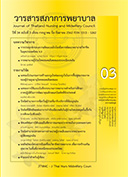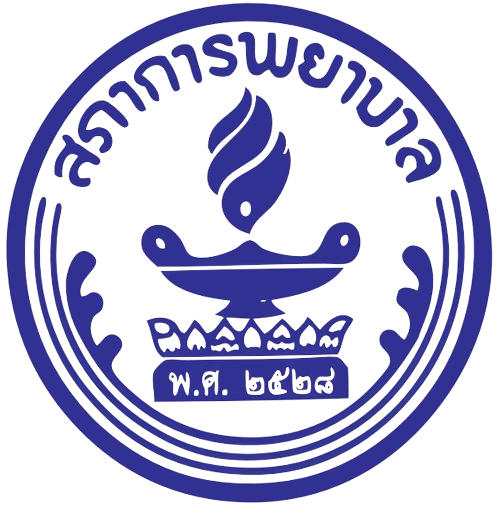Caring Process for Acute Stroke Patients
Keywords:
empirical evidence, caregiving, acute strokeAbstract
A stroke is a serious cerebrovascular syndrome that may result in death or paralysis, with severe consequences on the patient’s physical, intellectual, cognitive and psychosocial conditions. Economically, strokes affect not only the patients’ families but also the country. Stroke patients may suffer permanent paralysis, resulting in total dependency caused by their inability to work or support themselves.
When an acute stroke occurs, the brain suffers a suddenly decreased supply of blood. During this stage, the brain matters are still not permanently damaged, and the patient has a good chance of recovering if appropriate and timely treatment is provided. As the initial phase of an acute stroke is critical, specialised care by an interdisciplinary team plays a crucial part in saving the patient’s life, reducing the severity of paralysis or disability and minimising complications. Nurses play a pivotal part in every stage of stroke patient treatment, particularly during the frst 72 hours. Excellent nursing care can help stroke patients achieve positive treatment outcomes.
This article presents a set of guidelines and roles for nurses caring for acute stroke patients. Developed using empirical evidence, these guidelines and roles pertain to the following areas: neurological assessment, intracranial pressure control, blood pressure management, body temperature management, blood glucose management, oxygen therapy, body positioning, hydration, feeding, swallowing, bladder and bowel management, body movement, prevention of deep vein thrombosis, and depression management. The information presented herein can be applied to designing an appropriate caregiving practice and developing an effcient caregiving programme for acute stroke patients.
Downloads
References
of stroke for the 21st century: a statement for healthcare professionals from the American Heart Association/ American Stroke Association. Stroke 2013;44(7):2064-89.
2. Feigin VL, Norrving B, Mensah GA. Global burden of stroke. Circ Res. 2017;120(3):439-48.
3. International Health Policy Program Foundation. Burden of disease Thailand 2014. Nonthaburi: Graphigo Systems; 2017. (in Thai).
4. Summers D, Leonard A, Wentworth D, Saver JL,Simpson J, Spilker JA, et al. Comprehensive overview of nursing and interdisciplinary care of the acute ischemic stroke patient: a scientifc statement from
the American Heart Association. Stroke 2009;40(8): 2911-44.
5. Powers William J, Rabinstein Alejandro A, Ackerson T, Adeoye Opeolu M, Bambakidis Nicholas C, Becker
K, et al. 2018 Guidelines for the early management of patients with acute ischemic stroke: a guideline
for healthcare professionals from the American Heart Association/American Stroke Association. Stroke
2018;49(3):e46-e99.
6. Middleton S, Grimley R, Alexandrov AW. Triage, treatment, and transfer: evidence-based clinical practice recommendations and models of nursing care for the frst 72 hours of admission to hospital for acute stroke. Stroke 2015;46(2):e18-25.
7. Gray JA, Chambers LW. Evidence-based healthcare: how to make health policy & management decisions.
CMAJ 1997;157(11):1598-9.
8. Struwe JH, Baernholdt M, Noerholm V, Lind J. How is nursing care for stroke patients organised? Nurses’
views on best practices. J Nurs Manag 2013;21(1): 141-51.
9. Goldstein LB, Samsa GP. Reliability of the National Institutes of Health Stroke Scale. Extension to
non-neurologists in the context of a clinical trial. Stroke 1997;28(2):307-10.
10. Nilanont Y, Phattharayuttawat S, Chiewit P, Chotikanuchit S, Limsriwilai J, Chalernpong L, et al. Establishment of the Thai version of National Institute of Health Stroke Scale (NIHSS) and a validation study. J Med Assoc Thai 2010;93(Suppl.1):S171-8.
11. Schlegel D, Kolb SJ, Luciano JM, Tovar JM, Cucchiara BL, Liebeskind DS, et al. Utility of the NIH Stroke
Scale as a predictor of hospital disposition. Stroke 2003;34(1):134-7.
12. Murtha LA, McLeod DD, Pepperall D, McCann SK, Beard DJ, Tomkins AJ, et al. Intracranial pressure elevation after ischemic stroke in rats: cerebral edema is not the only cause, and short-duration mild hypothermia is a highly effective preventive therapy. J Cerebr Blood Met: offcial journal of the International
Society of Cerebral Blood Flow and Metabolism 2014;35(4):592-600.29
13. Woodward S, Mestecky A-M. Neuroscience nursing: evidence-based theory and practice. London: A John
Wiley & Son; 2011.
14. Shao L, Hong F, Zou Y, Hao X, Hou H, Tian M.Hypertonic saline for brain relaxation and intracranial
pressure in patients undergoing neurosurgical procedures: a meta-analysis of randomized controlled trials. PLoS One 2015;10(1):e0117314.
15. Hong K-S. Blood pressure management for stroke prevention and in acute stroke. J Stroke 2017;19(2):152-65.
16. Middleton S, McElduff P, Ward J, Grimshaw JM, Dale S, D’Este C, et al. Implementation of evidence-based
treatment protocols to manage fever, hyperglycaemia,and swallowing dysfunction in acute stroke (QASC):
a cluster randomised controlled trial. Lancet 2011;378(9804):1699-706.
17. Sjoberg F, Singer M. The medical use of oxygen: a time for critical reappraisal. J Intern Med 2013; 274(6):505-28.
18. Ali K, Cheek E, Sills S, Crome P, Roffe C. Day–night differences in oxygen saturation and the frequency
of desaturations in the frst 24 hours in patients with acute stroke. J Stroke Cerebrovasc 2007;16(6):239-44.
19. Favilla CG, Mesquita RC, Mullen M, Durduran T, Lu X, Kim MN, et al. Optical bedside monitoring of
cerebral blood flow in acute ischemic stroke patients during head-of-bed manipulation. Stroke 2014; 45(5):1269-74.
20. Anderson CS, Arima H, Lavados P, Billot L, Hackett ML, Olavarría VV, et al. Cluster-randomized, crossover
trial of head positioning in acute stroke. New Engl J Med 2017;376(25):2437-47.
21. Liebeskind DS. Hydration and collateral flow in acute stroke. Eur J Neurol 2016;23(3):433-4.
22. Kelly J, Hunt BJ, Lewis RR, Swaminathan R, Moody A, Seed PT, et al. Dehydration and venous thromboembolism
after acute stroke. QJM-INT J MED 2004;97(5): 293-6.
23. Dennis M, Lewis S, Cranswick G, Forbes J. FOOD: a multicentre randomised trial evaluating feeding
policies in patients admitted to hospital with a recent stroke. Health Technol Assess 2006;10(2): 1-120.
24. Prasat Neurological Institute. Clinical Nursing Practice Guidelines for Stroke. Bangkok: Tana press; 2015.
(in Thai).
25. Son SB, Chung SY, Kang S, Yoon JS. Relation of urinary retention and functional recovery in stroke
patients during rehabilitation program. Ann Rehabi Med 2017;41(2):204-10.
26. Bernhardt J, Godecke E, Johnson L, Langhorne P. Early rehabilitation after stroke. Curr Opin Neurol
2017;30(1):48-54.
27. Towfghi A, Ovbiagele B, El Husseini N, Hackett Maree L, Jorge Ricardo E, Kissela Brett M, et al.
Poststroke depression: a scientifc statement for healthcare professionals from the American Heart Association/American Stroke Association. Stroke 2017;48(2):e30-e43.
28. American Psychiatric Association. Diagnostic and statistical manual of mental disorders 5th ed. Washington, DC 2013.








